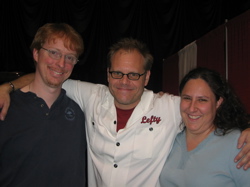Clay Shirky recently published a missive titled “Group as User: Flaming and the Design of Social Software” that I almost dropped into the Distractions list, but then realized I wanted to write about in a little more detail. Clay talks about mailing lists as one of the oldest forms of social software, and how they tend to become clogged with flame wars. He makes the case that since flame wars are inevitable in a group setting, there should be mechanisms that help prevent and control the fires. For the most part, I agree with him that some mechanisms would be a good idea. I do not, however, accept that flaming is inevitable.
I can draw on personal experience to make this claim. I’ve been responsible for a mailing list (css-discuss) for almost three years now. In that time, the list grew so large that it started to overload its home, and had to migrate to a more capable host. As of this writing, the membership list stands at 5,128 subscribed accounts. That’s not a typo. Bear in mind that any account that is disabled due to excessive bounces gets automatically removed after a couple of weeks, so the amount of deadwood is pretty low.
So, yeah, I know what it’s like to be a part of a very large mailing list community. Over the lifetime of the list, we’ve had very, very few flame wars. (Most of them have centered around font sizing, unsurprisingly enough.) And what we call a flame war would hardly even raise an eyebrow in most online fora. By the standards of the css-d community, any thread that contains more than two agitated posts is considered a flame war. Posts where list members actually insult each other are rare as moon cheese. Condescension is a little more common, but not by much.
We aren’t running magic software to make this happen; the list is running on Mailman 2.1b5. What’s made the difference is me.
Warning! Ego alert! Ego alert!
Actually, not at all. From the very first, I’ve worked hard to make sure list members understand the nature of the community. It is not a democracy, and it isn’t an anarchy. It’s a benevolent dictatorship. This is no secret: I’ve said so on the list at least a couple of times. I try not to wield the Brickbat Of Administrative Correction unless necessary, and when I do, I do so in as neutral and even-handed a manner as possible. In the end, though, I make it very clear that within the confines of that community, my word is effectively law. I decide what’s on topic, and what isn’t, and gently make my decisions known. End of story. When I call for a thread to end, it ends. Or else. If list members ask for changes to the list’s nature, as happens from time to time, I listen to their reasoning and then make a decision. That’s it.
Maybe that all sounds like a guy on a massive power trip, but honestly, I’d much prefer that I didn’t have to make those calls. I’d prefer to have a community where the members keep themselves in line. That’s actually possible so long as the community is very small, and everyone both listens and is heard. In a large community, it’s effectively impossible. Even if 99% of the list membership is adult, the 1% can ruin things for everyone else. On css-d, a 1% flame rate would mean 50 members were out of line. In absolute terms, that’s unacceptable. Thus I actively watch and chaperone the list. I also wrote some material enumerating the policies, how to avoid being offended, and the right way to answer questions. People really like that material. I’ve been asked permission to re-use that material several times.
I also participate in the community as best I can, setting an example for how questions should be answered and list members should act. Of late, I’ve been too swamped to offer more than token participation on the list, which is why I just yesterday selected four list members to be moderators. They’ll be helping with administrivia, but more importantly, will be helping to keep things on-topic and civil, although I honestly don’t expect them to have to work very hard at that last part. Heck, I’ve been an absentee dictator for a couple of months now, and things have stayed mostly on-topic and very civil. Basically, having put the effort into rolling this massive boulder in a certain direction, it kept going that way even when I stopped actively pushing for a while. Just recently, things have started to deteriorate a bit. That was a major impetus to get off my keister and pick some moderators.
So I guess my point is that there’s more to a community than its members. The founder’s influence is strong, and if the community has someone (or several someones) actively in charge who can make my-way-or-the-highway decisions but still be reasonable about them, it can be kept very nearly flame-free.
Still, some of the ideas Clay discusses would be very useful, even in an already-civil environment like css-d. He proposes, for example, adapting features of the Slashdot karma/moderation system to mailing lists. In the css-d context, such a system would probably function more like the eBay “Rate This Seller” feature; for us, it would be a “Rate This Member” mechanism that could communally identify those who are helpful, knowledgeable, and so on. Similarly, a “Rate This Thread” could be used to identify topics of interest as well as topics that nobody wants to hear about. (Like font sizing.) I believe that by getting distributed, evolving community input of that kind, the list would be strengthened and enriched.
It would be interesting to add such features, but in the current environment, I don’t see a way to do so—and, let’s face it, I’m not the world’s most proficient programmer. Right now it’s mostly something to keep in mind for the future. Especially if you happen to be working on mailing list software.


 We stood in line to get our copies of his books signed, and also to thank him for his Thanksgiving turkey recipe, which quite literally changed how we cook. I also told him
We stood in line to get our copies of his books signed, and also to thank him for his Thanksgiving turkey recipe, which quite literally changed how we cook. I also told him